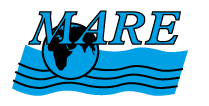A program of the Lawrence Hall of Science that seeks to increase ocean literacy through informal and formal education initiatives
A Drop of Water
Beginning with a child exploring the water in a creek, Morrison imagines how a drop on his finger made its journey through the water cycle. Detailed, multicolored illustrations take readers high in the sky as the red-tailed hawk flies and the raindrops fall, providing a view of the marsh and the mountain stream from above. Finally, the pictures zoom back to a close-up of the boy to complete the circle. Readers can appreciate this narration on two levels: first, as a simple story of the hydrologic cycle; and second, as a search to find various types of plants and animals.
Beyond the Moon: A Conversational, Common Sense Guide to Understanding the Tides
Finally, someone has written a comprehensive, easily readable explanation of the tides on earth that is both simple enough for students and solid enough for their professors. Step by step, by analogy and illustration, Beyond the Moon describes how the cyclical motion of the near solar system is impressed upon the earth’s oceans, and how the hydraulics over the continental shelf and the geography of the coastline orchestrate this rhythm into the bewildering variety of tide patterns seen around the globe.
Pagoo
This is the classic story of Pagoo, a hermit crab, as he grows and learns about life in the sea. Selected passages could be read aloud to help students learn more about some of the organisms mentioned. Or students could browse through the book and pick up plenty of information from the illustrations.
A Field Guide to Seashores Coloring Book
This coloring book shows all the most common seashore habitats from Maine to California. Children can learn about sea life with these scientifically accurate illustrations.
A Tidal Pool
Underwater forests of kelp, armor-plated barnacles, flower-like sea anemones, spiny sea urchins, and swooping gulls all live together in a tide pool. This book would be a good student reference for 4th graders studying the bottom dwellers of a kelp forest as well as a good resource for teachers focused on the 1st grade rocky seashore curriculum. Descriptions of the ecological relationships of the different plants and animals that live in low, mid, and high-tidal zones.
Grasper: A Young Crab's Discovery
Grasper, a small crab living in an overcrowded tide pool, sheds his hard shell and finds out that there is a bigger and better place in the world beyond. While this work is fiction, the descriptions of molting in crustaceans is fairily accurate and simple enough for young children to understand. Bright and beautiful illustrations make this a great book for read-aloud and discussion.
Marine and Estuarine Ecology
This book is written at a high school level, but can be used as a reference by teachers in a number of habitats.
A high school textbook and workbook introducing marine and estuarine ecology, marine habitats, and the diversity of marine animals and plants.
Earth: The Water Planet
Designed for middle-level Earth science teachers, Earth: The Water Planet explains how to use readily available materials and a variety of instructional methods to investigate how water shapes our planet and daily lives. Included are hands-on experiments challenging you to purify swamp-water, conservation-oriented activities showing how much water is wasted by a dripping faucet, and a role-playing activity in which students present opposing arguments at a town meeting.
Animals of the Seas and Wetlands
The Sea Is Calling Me: Poems
From the publisher: Seagulls, sandcastles, seashells, and sips of ocean wash over the pages of this fine collection of sea poems. Hopkins has again gathered works from varied poets (E. E. Cummings, Karla Kuskin, Aileen Fisher, Myra Cohn Livingston), choosing them carefully like precious seashells. Many of the poems, published previously, are reprinted from collections now out of print. Several poems are printed here for the first time. The blue and black ink illustrations complement the poetry.
Pages




